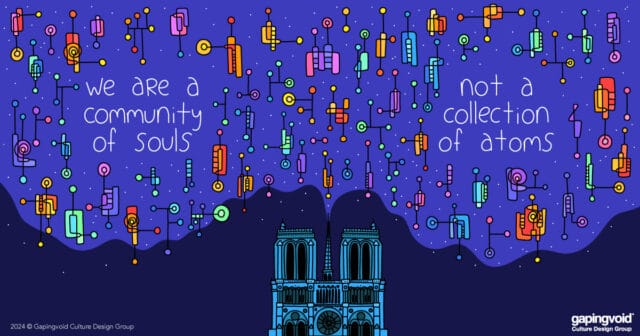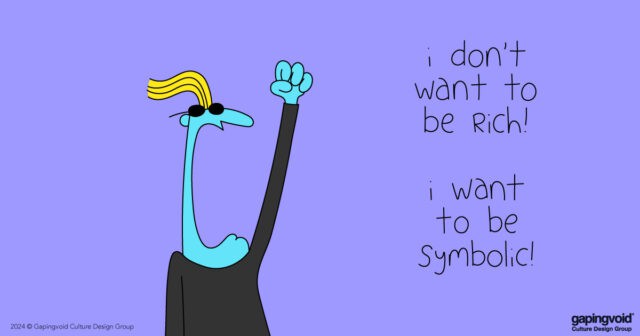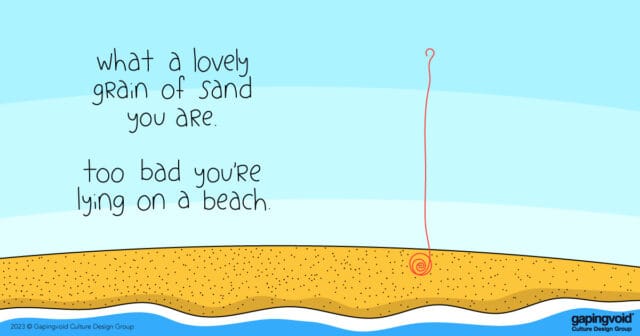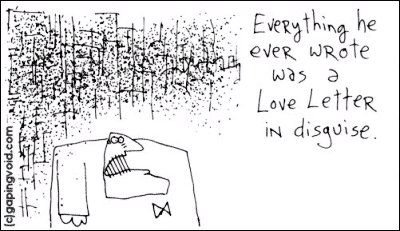
When I first started putting up cartoons onto gapingvoid in 2001, they were in a small, 400-pixel-wide format, just like the “Love Letter” cartoon you see above.
Then about 2 years ago, I started posting them in high-resolution, like the “Dinosaur” cartoon below [Click on the image and the high-res version will pop up].
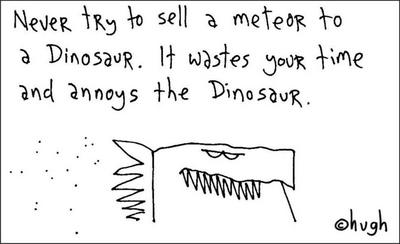
This meant people could actually download the images and start using them for their own stuff. Like I said in my licensing terms,
Hey, if you want to put the work up on your website, blog, or stick it on paper, t-shirts, business cards, stickers, homemade greeting cards, Powerpoint slides, or whatever, as far as I’m concerned, as long as it’s just for your own personal use, as long as you’re not trying to make money off it directly, and you’re giving me due attribution, I’m totally cool with the idea.
As a “Social Object”, a cartoon that one can actually print out and hang on their cube wall, or put on a t-shirt, a business card etc is far more powerful and useful than say, YET ONE MORE IMAGE you can find on the internet and e-mail en masse to your friends.
i.e. The cartoon itself hasn’t changed, but the interaction between it and the “End User” is suddenly far more meaningful.
So of course, the next layman’s question is, “Yes, but… how do you monetize it?”
And of course, the answer is, “Indirectly”.
For example, in October, 2006 I post the Microsoft Blue Monster cartoon. Within a few months Microsoft is somehow paying me a lot of money to do other drawings for them. Without the former, the latter would never have happened. And without the latter, Sun Microsystems would never have approached me. Everything feeds into everything else. Exactly.
In other words, I don’t create the online cartoons as “products” to be sold. I create the cartoons as “Social Objects”, i.e. “Sharing Devices” that help me to build relationships with.
As with all things, the REAL value comes from the human relationships that are built AROUND the social object, not the object in itself.
I’ll quote my friend, Mark Earls one more time. This is from his second book, “Herd”:
“Cova is surely right to suggest that much of modern consumer behaviour is social in nature. We do it not just in a social context (tangible and immediately present or over distances) but for social reasons — that is the object or activity is the means for a group or tribe to form or interact. This also echoes a lot of what Douglas Atkin describes in his study of cult brands — brands which have developed a cult status (like Apple, and Ford’s bestselling pickup) seem to serve an underlying social need within each individual (just as religious cults do): a need to belong. The real draw is probably not the brand but… other people.”
And I’ll also ask my favorite question, one more time: If your product is not a “Social Object”, how on earth do you manage to stay in business?

